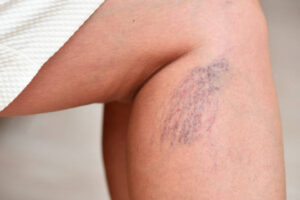What You Need to Know About Vein Disease (The Silent Killer)
Your body is made up of many moving parts, but mostly, we think about our main organs when we think about our health. We all want strong hearts, lungs, kidneys, etc. but what about our veins? They are vital to carrying our blood back to our heart, yet we often overlook them.
 Veins are a type of blood vessel, along with capillaries and arteries. If all of our blood vessels were stretched out, they would cover about 100,000 miles, according to The Franklin Institute.
Veins are a type of blood vessel, along with capillaries and arteries. If all of our blood vessels were stretched out, they would cover about 100,000 miles, according to The Franklin Institute.
So what happens when a vein is damaged? It impedes your circulation system and allows blood to collect and flow backward. As the high pressure in the vein continues to increase, the vein continues to stretch and twist and will start to swell up to the point where a blood clot may form. This worsening condition is called venous disease and because it’s happening inside our veins, which we established are often overlooked, this disease is also referred to as the silent killer.
Venous disease is also common. According to John Hopkins University, about 15% of the U.S. population is affected by varicose veins treatment Miami. Varicose veins may not pose a threat on their own, but thrombophlebitis can become life threatening.
What is Thrombophlebitis?
It is the inflammation of the vein that happens in response to a blood clot. When it happens in a vein that’s near the surface of your skin, it’s called superficial thrombophlebitis. It’s a minor disorder that causes the vein to look red and feel tender. However, if the inflammation occurs in a larger vein, deeper under the skin, it’s called deep-vein thrombosis or DVT, and it’s much more serious.
The notion to keep in mind with this condition is that half of the cases of DVT start out asymptomatic (meaning little or no symptoms occur) but the result is a possible pulmonary embolism. This happens when the clot moves to the lung. Blood clots can also cause chronic venous insufficiency (where the blood flow through the veins is weakened and back flow and increased pressure occur), and this can be seen by skin pigmentation and swelling.
Symptoms of Venous Disease
Varicose veins, which are created when vein walls weaken and valves allow blood to flow backward in the vein. They can be seen under your skin as twisted and swollen with a purple hue. They are quite common and rarely result in any serious health risks, but they can cause an achy or heavy sensation in the legs. They can lead to leg discoloration, swelling, heaviness, aching and on rare occasion ulcerations or phlebitis.
Similarly, superficial thrombophlebitis causes veins to become red and engorged, which also brings with it swelling, tenderness and pain.
On the other spectrum, deep-vein thrombosis symptoms can range from very swollen extremities to just swelling and some redness and heaviness in the legs.
The best thing to do is to contact us at Fox Vein & Laser Experts if you have a painful or swollen vein that doesn’t disappear within a few days, or if you have sudden and unexplained swelling in your arm or leg.
What Causes This?
Thrombophlebitis is common in bedridden patients because of their inability to move. If you are not bedridden, moving around and making sure your blood doesn’t become inactive is very important. Other ways you can suffer from thrombophlebitis is if you have suffered a trauma that injured a blood vessel or long flights or travel where you are not moving for long periods of time. This has been referred to as coach class syndrome. Superficial thrombophlebitis is also common in pregnant women, who have a higher risk of producing varicose veins and a higher risk of clots due to the hormones and physiological changes during pregnancy. Deep-vein thrombosis has been associated with several cancers and their treatments, as well.
As we already discussed, an easy way to help prevent thrombophlebitis is by making sure you are not sitting or standing for long periods of time. The movement will help your circulation, so whether you’re at your desk at work or on a plane, make sure you’re moving around once every hour. As well, stay hydrated and wear compression hose if possible.
If you’re worried about possibly suffering from thrombophlebitis, the best first step to take is to make an appointment to come into our office and meet with Dr. Susan Fox. Superficial thrombophlebitis can usually be diagnosed by a physical examination of your body and a review of your family history. However, to diagnose deep-vein thrombophlebitis we may need to perform additional tests including an ultrasound t to see how your veins are returning blood to the heart. Usually, the physician even with a superficial clot will get an ultrasound to make sure that there is no deep vein clot associated with it.
Can Thrombophlebitis be Treated?
Yes! There are a few ways to do this – some are less involved, while others require a doctor’s visit and possible treatments. At home, prop your feet up against a wall and lay on the floor. Elevating your feet can do wonders for your circulation. You can also use pillows to elevate your feet 4-6 inches above your heart while you sleep. If you do have phlebitis, an Aventura vein doctor needs to evaluate and see if it is only superficial or also deep. If it is a deep clot, you will need medication to treat this called blood thinners. If it is a superficial thrombosis usually warm packs, compression hose and anti-inflammatories are the mainstays.
 If your condition is more severe, there are a few procedures that may help you using stents and blood thinners.
If your condition is more severe, there are a few procedures that may help you using stents and blood thinners.
The venous disease may be called the silent killer, but by being aware of your body and the possible symptoms, you can be proactive and send a loud message to venous disease that you’re not going to let it dictate your life. Contact our vein center Miami, Fox Vein & Laser Experts,to make your initial consultation appointment with Dr. Fox, one of the area’s leading experts in diagnosing and treating venous disease.

